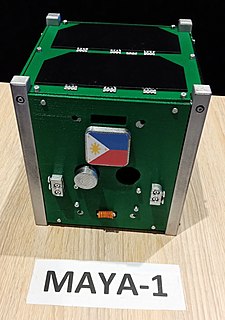
The space program of the Philippines is decentralized and is maintained by various agencies of the Department of Science and Technology (DOST). There is no dedicated space agency to oversee the country's space program and is funded through the National SPACE Development Program by the DOST. Early Philippine initiatives in space technology has been led by private firms although in the recent years the government has played a more active role.

The Philippines' Department of Science and Technology, is the executive department of the Philippine Government responsible for the coordination of science and technology-related projects in the Philippines and to formulate policies and projects in the fields of science and technology in support of national development.

The National Space Promotion, Awareness, and Capabilities Enhancement (SPACE) Development Program, simply known as the National SPACE Development Program (NSDP) is a government program of the Philippines set up to craft a policy for the country's space program and lay the foundation of a future dedicated space agency. The program is made under the Philippine Council for Industry, Energy and Emerging Technology Research and Development (PCIEERD) of the Department of Science and Technology.
Contents
- Organization
- Founding of a unified agency
- History
- Earlier developments
- Early space program initiatives
- PASI and Mabuhay's satellite ventures
- Government initiatives in the 2010s
- Space education
- See also
- References
The Philippines has been involved in space technology since the 1960s, when the government built an Earth satellite receiving station by the administration of then-President Ferdinand Marcos. It was also during the latter part of this period that a Filipino private firm acquired the country's first satellite, Agila-1 which was launched as an Indonesian satellite. In the 1990s, Mabuhay had Agila 2 launched to space from China.

Ferdinand Emmanuel Edralin Marcos Sr. was a Filipino politician and kleptocrat who was the tenth President of the Philippines from 1965 to 1986. A leading member of the far-right New Society Movement, he ruled as a dictator under martial law from 1972 until 1981. His regime was infamous for its corruption, extravagance, and brutality.
Agila-1 or Mabuhay was launched in March 20, 1987, under the name Palapa B2-P in Cape Canaveral Air Force Station. It was originally under Indonesian company, PT Pasifik Satelit Nusantara until it was acquired by Philippine company, Mabuhay Satellite Corporation which is under PLDT in 1996. Upon its acquisition by Mabuhay, it became the first Philippine satellite through acquisition while in orbit. Palapa B2-P was later renamed to "Agila-1", the local name for the Philippine eagle. The satellite's operation ended in January 1998 and was deorbited.

Mabuhay Satellite Corporation (MSC) was a Filipino aerospace corporation responsible for operating communication satellites and before 2009, the only Philippine company to do so. It was later renamed as Mabuhay Investment Corporation (MIC) and became a holding company owned by PLDT. It once owned the Agila 2 satellite which provides coverage in the Asia-Pacific region. Aside from satellite operation, it also provided satellite-related services. It operated two space centers, namely the Mabuhaysat Subic Space Center, its main hub, and the Mabuhaysat Zamboanga Space Center at Zamboanga City, its back-up hub.
In the 2010s, the Philippine government partnered with the Tohoku and Hokkaido Universities of Japan to launch the first satellite designed by Filipinos, Diwata-1. Diwata-1 is a microsatellite. The government was able to develop and send two more small-scale satellites, Diwata-2 and Maya-1. A centralized space agency has been proposed in the legislature to address funding and management issue faced by the country's space program.

Tohoku University, abbreviated to Tohokudai, located in Sendai, Miyagi in the Tōhoku Region, Japan, is a Japanese national university. It was the third Imperial University in Japan and is one of the National Seven Universities. It is considered one of the most prestigious universities in Japan, and one of the top fifty universities in the world.

Hokkaido University, or Hokudai (北大), is a Japanese national university in Sapporo, Hokkaido. It is a member of the Imperial Universities, which were established to be the nation's finest institutes of higher education or research. It is located in downtown Sapporo, just north of Sapporo Station, and stretching approximately 2.4 kilometers northward. It is considered one of the top universities in Japan.

Diwata-1 also known as PHL-Microsat-1 is a Philippine microsatellite launched to the International Space Station (ISS) in March 23, 2016, and was deployed into orbit from the ISS in April 27, 2016. It is the first Philippine microsatellite and the first satellite built and designed by Filipinos.



















